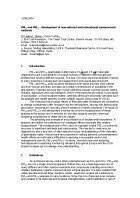Air Monitoring
PM10 and PM2.5 - development of new national and international measurement methods
Oct 06 2014
Author: Dr Lesley L Sloss, Dave Curtis on behalf of CEM
1 Introduction
PM10 and PM2.5 (particulate matter below 10 and 2.5 in diameter respectively) are a combination of a large number of different chemical species emitted from several different sources. The lack of a clear chemical definition has led to many problems in areas such as measurement and source apportionment.
PM10 and PM2.5 arise as direct emissions from some sources, both natural and from human activities, and also as a result of interactions of pollutants in the atmosphere. Potential sources from human activities include coal-fired power plants, industry, agriculture and road transport. Some of the particles are solids: by-products of combustion, or incombustible matter; whereas others are secondary aerosols such as sulphate and nitrate species or semi-volatile organic compounds (SVOCs).
The chemical and physical nature of fine particulate emissions are considered to change considerably after emission into the atmosphere, varying with factors such as location, temperature, humidity and the presence of other pollutants. The study of PM10 and PM2.5 in the atmosphere involves not only the measurement of these species at the source and in ambient air, but also requires complex chemical modelling programmes to relate the two values.
The sampling and analysis of any pollutant is of fundamental importance. A species can neither be understood nor managed without accurate and reliable measurement. The measurement of PM10 and, to a greater extent, PM2.5 is known to prone to significant artefacts and inaccuracies. This has led to what may be regarded by some as a lack of valid data and a poor understanding of the chemistry of particulate matter. Hence there are problems in relating ambient concentrations to health effects and ultimately difficulties in applying a successful control and management plan for PM10 and PM2.5. However, new and improved sampling techniques and expanding monitoring networks throughout Europe and the USA should increase our knowledge and understanding.
Digital Edition
AET 28.2 April/May 2024
May 2024
Business News - Teledyne Marine expands with the acquisition of Valeport - Signal partners with gas analysis experts in Korea Air Monitoring - Continuous Fine Particulate Emission Monitor...
View all digital editions
Events
Jul 30 2024 Jakarta, Indonesia
China Energy Summit & Exhibition
Jul 31 2024 Beijing, China
2024 Beijing International Coal & Mining Exhibition
Aug 07 2024 Beijing, China
IWA World Water Congress & Exhibition
Aug 11 2024 Toronto, Canada
Aug 25 2024 Stockholm, Sweden and online






.jpg)








